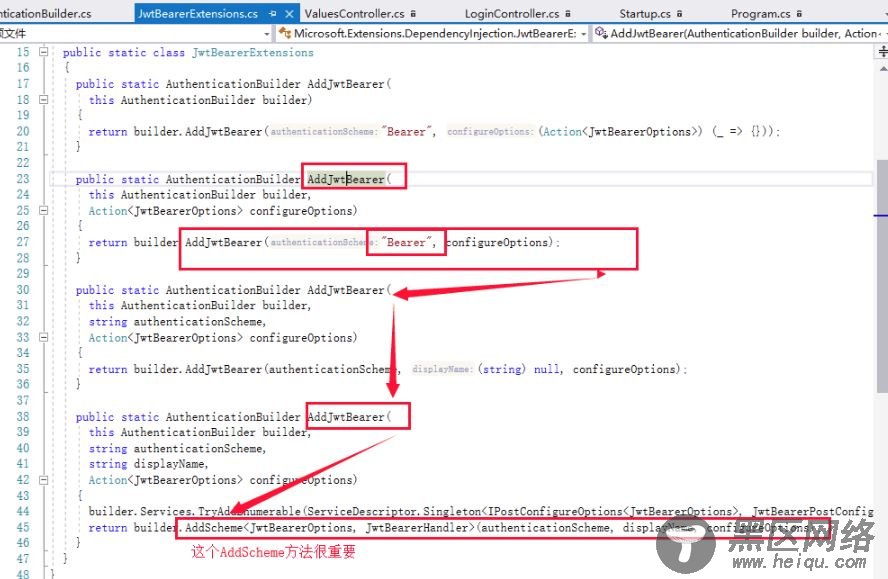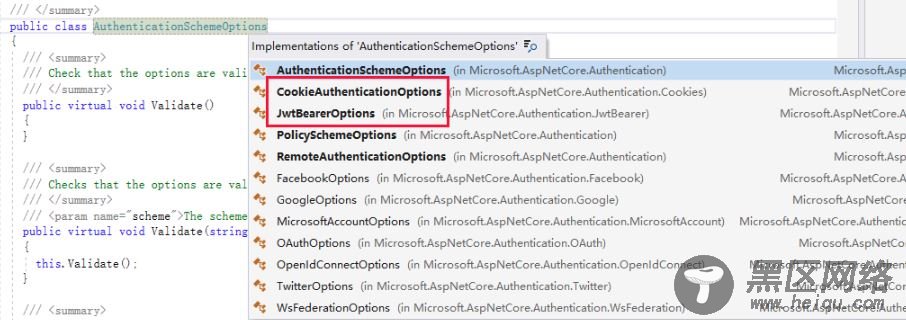在继续往下之前,我们先看一下这个认证中间件的作用结果,当认证通过时,在HttpContext的User属性(ClaimPrincipal)赋予身份标识,所以在后续的请求管道中都是基于认证结果中的身份标识做鉴权,这个我们会在后面的实际操作中会提到。
言归正传,在这里引出了我们的两个对象AuthenticationHandlerProvider,AuthenticationSchemeProvider。
重要对象讲解
IAuthenticationSchemeProvider
从名字来看,IAuthenticationSchemeProvider的作用应该是提供Scheme的,这也是Provider在微软的风格里面起的作用(类似于工厂模式)。
这个Scheme是什么呢?很明显,在Framework时代,也是有基于不同Scheme验证的,比如Bearer,Cookie,在Aspnet Core中定义不同的Scheme代表着不同的认证处理方式,具体体现是在每个Scheme中包含对应的IAuthenticationHandler类型的Handler,由它来完成跟自身Scheme相关的认证处理。如果没有定义会怎么样?仔细看上面这块源码,只有当AuthenticationScheme不为空时才会做认证,否则一旦在Controller打上鉴权标签[Authorize],将会直接返回401,所以我们必须指定自己的Scheme。
那么我们在哪里指定我们的Scheme类似呢?我们先返回到ConfigureService的AddJwtBearer,使用过的朋友们肯定知道,这里获取的Scheme是我们在ConfigureService通过Addxxx scheme指定的Scheme类型。这里我们是使用JWT的

在这里指定了TOptions 为JwtBearerOptions,而THandler为JwtBearerHandler。
public virtual AuthenticationBuilder AddScheme<TOptions, THandler>( string authenticationScheme, string displayName, Action<TOptions> configureOptions) where TOptions : AuthenticationSchemeOptions, new() where THandler : AuthenticationHandler<TOptions> { return this.AddSchemeHelper<TOptions, THandler>(authenticationScheme, displayName, configureOptions); } private AuthenticationBuilder AddSchemeHelper<TOptions, THandler>( string authenticationScheme, string displayName, Action<TOptions> configureOptions) where TOptions : class, new() where THandler : class, IAuthenticationHandler { this.Services.Configure<AuthenticationOptions>((Action<AuthenticationOptions>) (o => o.AddScheme(authenticationScheme, (Action<AuthenticationSchemeBuilder>) (scheme => { scheme.HandlerType = typeof (THandler); scheme.DisplayName = displayName; })))); if (configureOptions != null) this.Services.Configure<TOptions>(authenticationScheme, configureOptions); this.Services.AddTransient<THandler>(); return this; }
注意这里TOptions 是需要继承AuthenticationSchemeOptions的,在这里是JwtBearerOptions,而THandler是AuthenticationHandler<TOptions>类型的Handler,在这里是JwtBearerHandler。

我们回到Scheme的分析继续往下,首先看一下AuthenticationScheme的定义
public class AuthenticationScheme { /// <summary>Constructor.</summary> public AuthenticationScheme(string name, string displayName, Type handlerType) { if (name == null) throw new ArgumentNullException(nameof (name)); if (handlerType == (Type) null) throw new ArgumentNullException(nameof (handlerType)); if (!typeof (IAuthenticationHandler).IsAssignableFrom(handlerType)) throw new ArgumentException("handlerType must implement IAuthenticationHandler."); this.Name = name; this.HandlerType = handlerType; this.DisplayName = displayName; } /// <summary>The name of the authentication scheme.</summary> public string Name { get; } /// <summary> /// The display name for the scheme. Null is valid and used for non user facing schemes. /// </summary> public string DisplayName { get; } /// <summary> /// The <see cref="T:Microsoft.AspNetCore.Authentication.IAuthenticationHandler" /> type that handles this scheme. /// </summary> public Type HandlerType { get; } }
